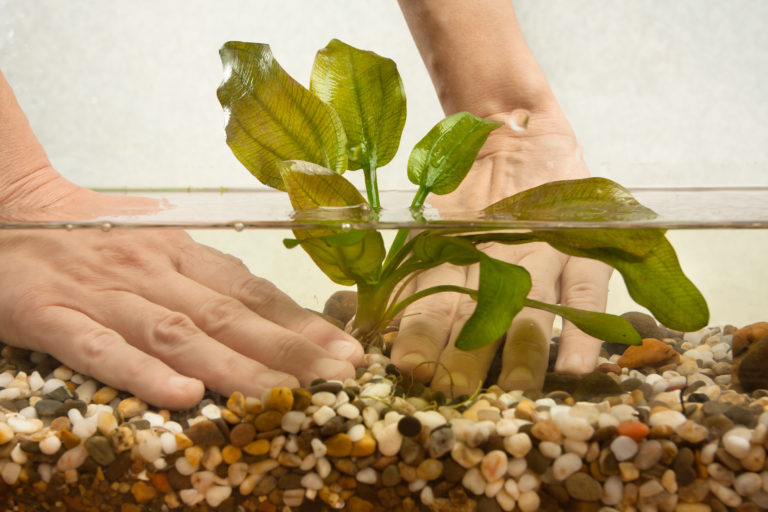Plants in an Aquarium: Starter Guide

© rodimovpavel / stock.adobe.com
hands of aquarist planting water plant echinodorus in new aquarium
Table of contents
Why aquatic plants?
Aquatic plants fulfil important tasks in the world of your fish. They offer hiding places for shy fish, with fast-growing plants reducing the burden on the water and enriching it with oxygen. Last but not least, healthy aquatic plants are a great focal point for any aquarium and provide a calming visual for any onlooker.
How many aquatic plants can be used?
If there are too many plants in your aquarium, it will quickly become overcrowded and valuable space will be lost. The following is a general rule of thumb for how many plants you can use:
Length in cm x width in cm divided by 50
e.g. 80cm x 35cm / 50 = approximately 56 plants.
Planting and design
You should be careful when choosing plants to go for a good mixture of slow- and fast-growing varieties. You also need to be aware that some plants, such as the Vallisneria, do not like to be alone, so you should always put at least three of these together. A basic principle to follow is that it is better to have more of one kind of plant rather than focusing on a diverse range of species.
Fast-growing plants that make a great background:
- Vallisneria americana (gigantea)
- Ceratopteris thalictroides
- Elodea
- Cerastium
Slow-growing plants for the foreground and middle:
- Cryptocoryne (crispatula, wendtii)
- Echinodorus (bleheri, martii)
- Anubias (barteri, barteri var. nana) etc.
It is easier to introduce plants once any decoration has already been placed inside the tank, as adding ornaments after planting may result in plants being crushed. You should take into account the light any plants will receive when you arrange them in the tank, as some require less light (e.g. the Anubias) whilst others need more (Vallisneria).
Cut the roots slightly before placing them into a hollow made in the floor, and be sure to cover them with plenty of gravel.
Ground
Any material used on the base of the aquarium should not be too fine, to ensure that the roots of plants receive sufficient nutrients and ventilation rather than rotting or dying. A grain size between 3-8mm is ideal and, although the choice of colour is up to you, you should bear in mind that dark gravel will take a great deal of light.
Underneath the gravel, cover the aquarium floor with a base layer of around 1-2cm of slow-release fertiliser, so that important nutrients can be absorbed gradually by the plant roots.
Fertilisation
As is often the case, less is more! Use an iron test kit to regularly ensure that your plants are receiving the right amount of nutrients, as too much can be just as harmful as too little. There is a specialist trade in aquatic fertiliser, including liquid fertilisers. A CO2 gas-injection fertiliser is less suited to beginners, as you need to have a greater understanding of the chemical balance within the tank. Organic CO2 sets that are easy to use can often be found for small tanks up to 80cm.
Maintenance
Try to avoid using particularly hard water, as most plant species feel more comfortable in softer waters. You should also be sure to change your water at regular intervals, so that fresh nutrients can be brought into the tank environment. Fast-growing plants will need to be trimmed and deadheaded regularly and any fluorescent lights in the tank should be replaced after a year at most. This is because the luminosity will decrease after a year, almost imperceptibly to the human eye but leaving the plants in near darkness.